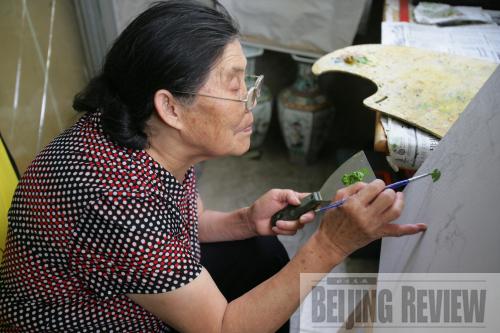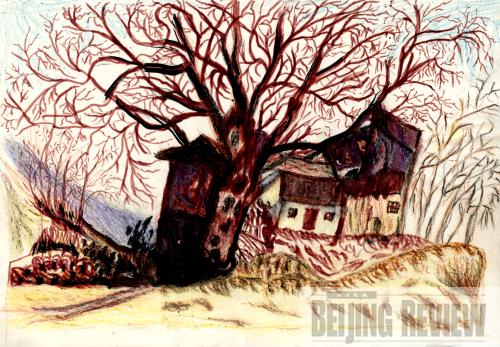|
 |
|
POPULAR PAINTER: Time with crayons and oil paints have soothed the loneliness of the elderly villager who moved to a strange city (COURTESY OF JIANG HUA) |
Chang Xiufeng, an illiterate village woman from central Henan Province, picked up crayons for the first time in her life when she was 70 years old. She used them to draw several hawthorn trees for her four-year-old granddaughter to show the little girl what her hometown looked like, a very different place from her adopted home of Guangzhou in south China.
Since then, her granddaughter has often asked her grandma to show the countryside through her drawings. One day, though, Chang's daughter-in-law, an art editor, found the paintings.
 |
|
SYMBOL OF HARDSHIP: Chang seldom puts her memories of hardships into her paintings, but the lonely house standing beside a tree in this one called Old House in Autumn always reminds her of bygone hard days (CHANG XIUFENG) |
Chang's nimble hands, agile mind and vivid memories had more uses than just wielding farm instruments. Her gorgeously colored paintings, especially those of sunflowers, won her the nickname of "Grandma Van Gogh" after one of her six children, Jiang Hua, posted them on the Internet.
The village painter even challenged the Dutch post-impressionist artist, Vincent Van Gogh, when she sat down with Chen Luyu, anchor of Hong Kong-based Phoenix Television in 2006. "His sunflowers are not better than mine," She told Chen and the audience. "Sunflowers cannot be in a vase. Without water and soil they would die."
Her childlike yet realistic crayon drawings have become hugely popular and aroused a feeling of nostalgia in the hearts of urban residents whose roots lay in rural villages.
"These paintings represent a personal record of China's countryside life. But for many who grew up in China's vast rural areas and are now making a living in cities, these represent their lost childhood as well as their hometowns that have already changed," said Chen Ken, publisher of Inner Lotus Bloom, a book of Chang's paintings. In the book, Chang's son, Jiang Hua, tells of the memories and stories behind the paintings.
My painting, my village
Painting gave the illiterate grandmother a voice to express her feelings and a tool to commemorate her family and bygone days.
"She is having a dialogue with herself and connecting with the past when drawing," Jiang said.
In the past five years, she has painted everything she remembers from her nearly 70 years in the mountain village in Henan. Her paintings focus on daily life such as old houses, neighbors, farming, village customs, trees and flowers.
"I still vividly remember what my village looks like. I don't need to think about what color should be used," she said.
Cherishing her past and contented with her happy life now with her son, Chang has buried memories of hardships deep in her heart and mainly uses bright, cheerful colors in her paintings.
But the dark colors of lonely old houses in winter betray her normally vivid and colorful scenes.
"The lonely house standing beside a tree [in a painting called Old House in Autumn] has existed in my mind for half a century and will always remind me of my hard life," she said.
The small Chinese village was home to 41 people from nine families who shared the surname Jiang. The village had no telephone until 2000, and years of drought decimated their crops.
When seeing Van Gogh's sunflowers for the first time, Chang felt his unhappiness. "He must have led a bitter life when he painted these sunflowers, because the colors are gloomy and some of the sunflowers are listless," she said.
| 